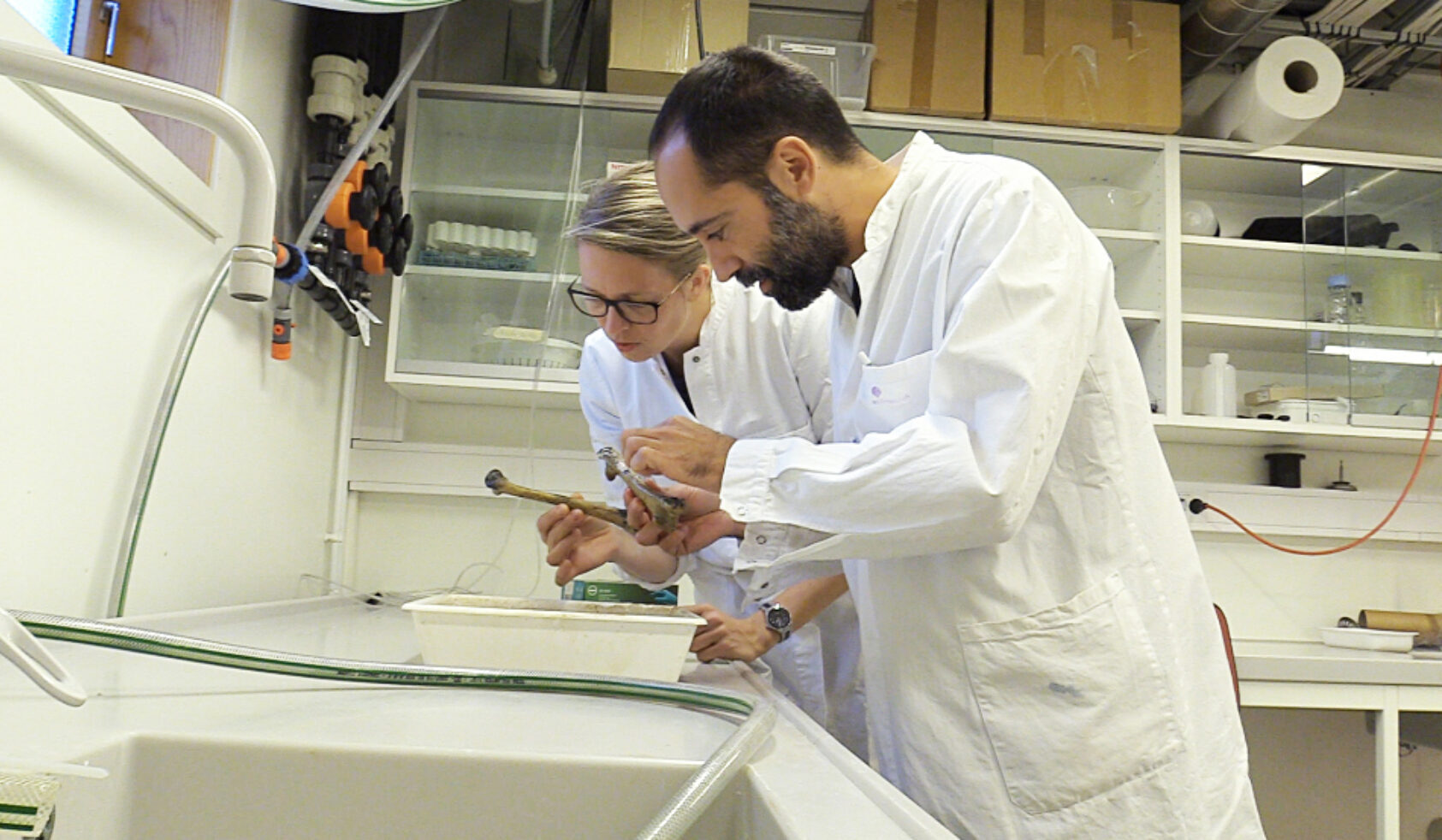This article is based on a press release written by EMBL’s European Bioinformatics Institute (EMBL-EBI). Read the press release here.
Back in 2022, NORCE researchers Antonio Garcia-Moyano and Gro Bjerga along with international colleagues put together a unique enzyme cocktail that breaks down bones more efficiently than individual enzymes. Read more about the finding here.
Discovering new enzymes to upcycle food waste

To support a growing global population, the food industry needs to use for example bones and skin from animals in food production. To make that happen, NORCE researchers are now trying to identify new enzymes that effectively can extract animal proteins from bones by using a specific database. The final product can be protein powder for animal and human consumption.

Source:
Andreas R. Graven
NORCE scientists Antonio Garcia-Moyano and Gro Bjerga.
What are enzymes?
Enzymes are biological catalysts. They drive chemical reactions without the need for lab-made chemicals that sometimes pollute the environment. Enzymes can be used to improve industrial processes.
The solution lay at the bottom of the ocean where they studied worms and microbes that live on the seafloor and ‘eat’ the bones of dead whales, extracting nutrients. These bacteria contain specific enzymes with bone-degrading properties.
This is an ingenious ability, but it does come with some difficulties. For example, many enzymes are sensitive to heat, which means they risk losing their properties above a certain temperature.

Source:
NORCE
The researchers lowered bones down to a depth of 60-100 metres in Byfjorden. (Still image from a ROV inspection)
Challenge – more protein, less waste
The United Nations predicts that the global population will peak before the end of the century at just over 10.4 billion people. Therefore, we need to devise new approaches for sustainable food production to feed this growing population.
One significant issue in animal production is the large amount of waste products, such as bones and skin. For instance, about 45% of a salmon’s total weight currently goes to waste because most people only use the fillet meat. Researchers have been exploring ways to use more of an animal’s body mass in food production, and consequently reduce waste and increase yields.
One way forward is to extract animal proteins from animal ‘by-products’ or ‘plus-products’, such as bones and skin, and use them in protein powders. Bones are particularly robust, however, making it a challenge to degrade and extract protein from them. To overcome this difficulty, researchers need a powerful agent, such as an enzyme cocktail.
The industry is on the hunt
However, the finding made the industry interested. They are always on the look for new and better enzymes, especially the right combinations of enzymes that has greater effect than single enzymes when it comes to bone degradation.
Having identified bone-degrading enzymes that live in marine environments, NORCE researchers focused on determining whether it would be feasible to use these enzymes in industrial processes, considering the following requirements:
a. large-scale production
b. expedited bone degradation (in nature, the process takes months
c. determining the optimal temperature for activity
d. ensuring scalability and sustainability.
Using database to identify bone-degrading enzymes
Now that researchers know what bone-degrading enzymes look like, they can use this knowledge to identify related enzymes with even more promising properties. To this end, researchers are taking advantage of the treasure trove of microbiome data housed in the MGnify database, which is managed by EMBL’s European Bioinformatics Institute (EMBL-EBI).
A publicly accessible resource, MGnify enables researchers to share, analyse, discover, and compare microbiome and protein sequence data in a comprehensive manner. It is a unique worldwide hub of large microbiome datasets from a range of environments, including many marine studies.
– MGnify will help us to identify the right enzyme or cocktail of enzymes with the traits required for a specific bioprocess, says Garcia-Moyano
An interdisciplinary effort
This work of identifying suitable enzymes for bone degradation is ongoing in the context of the wider BlueRemediomics where NORCE is one of the partners in the consortium. Blue Remediomics aims to systematically catalogue marine microbe datasets to facilitate the development of industrial processes that reduce waste, increase the reuse of natural and man-made products and by-products, and improve aquaculture processes.
Bone degradation is just one of many exciting applications explored by BlueRemediomics, which assembles experts from different disciplines.
The blue economy requires a range of expertise for its success, spanning microbiologists, molecular biologists, data scientists, bioinformaticians, biotech specialists, food manufacturers, and beyond. Translating a concept from the research laboratory to the market is a complex and lengthy process, but it can have a major impact.
Cross-disciplinary projects like BlueRemediomics represent an ideal platform to unite experts from diverse fields and explore the feasibility of new biotechnologies with potential applications in different industries.
The final products
Other companies can use such mass-produced enzymes to process animal bones and create protein powder, which can be upcycled into products for human consumption and animal feed.
NORCE researchers are in discussion with Norilia – a Norwegian company working on creating new products from meat and poultry industry plus-products. The company’s mission is to ensure that the whole animal is used and waste is minimised.